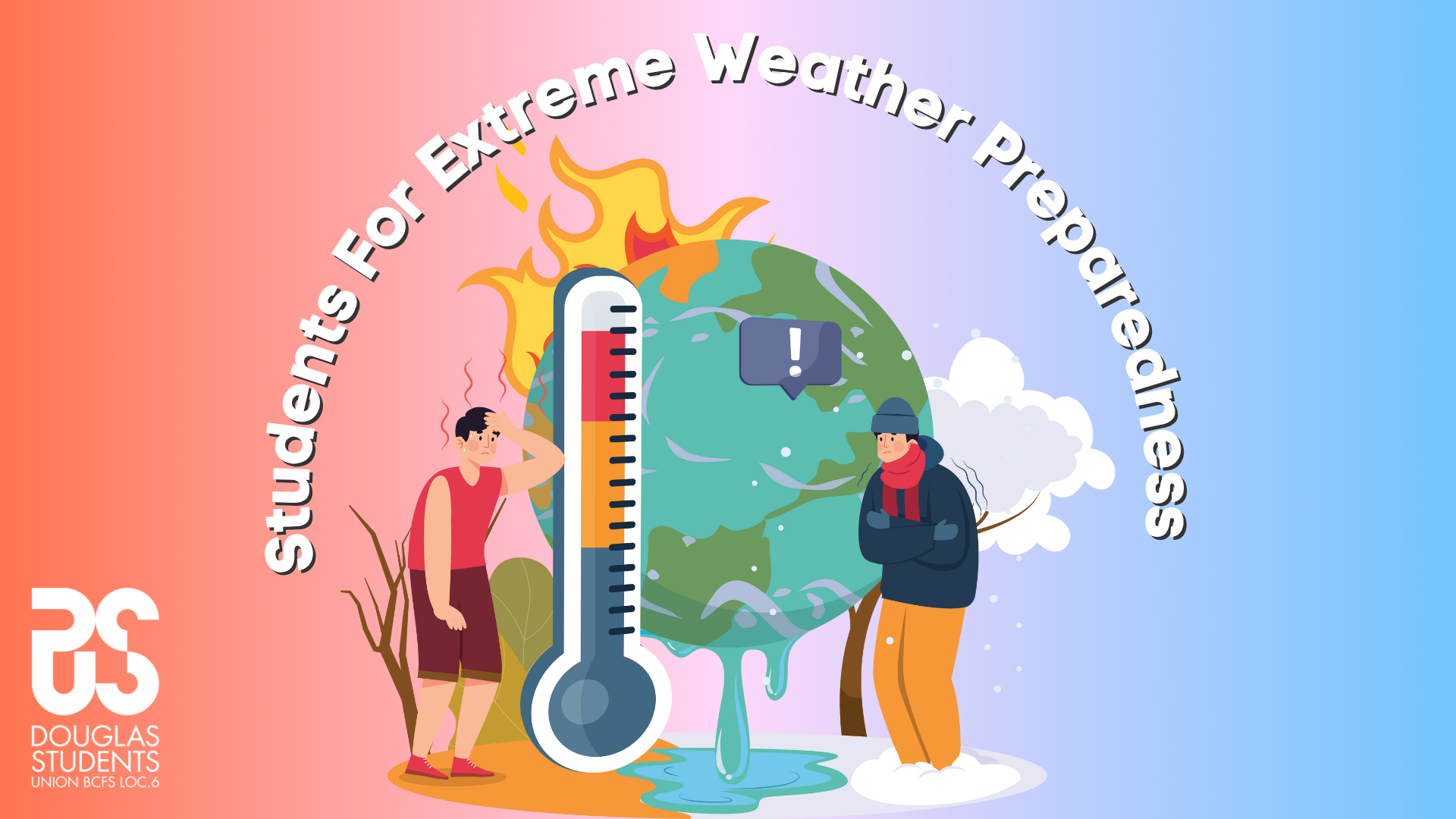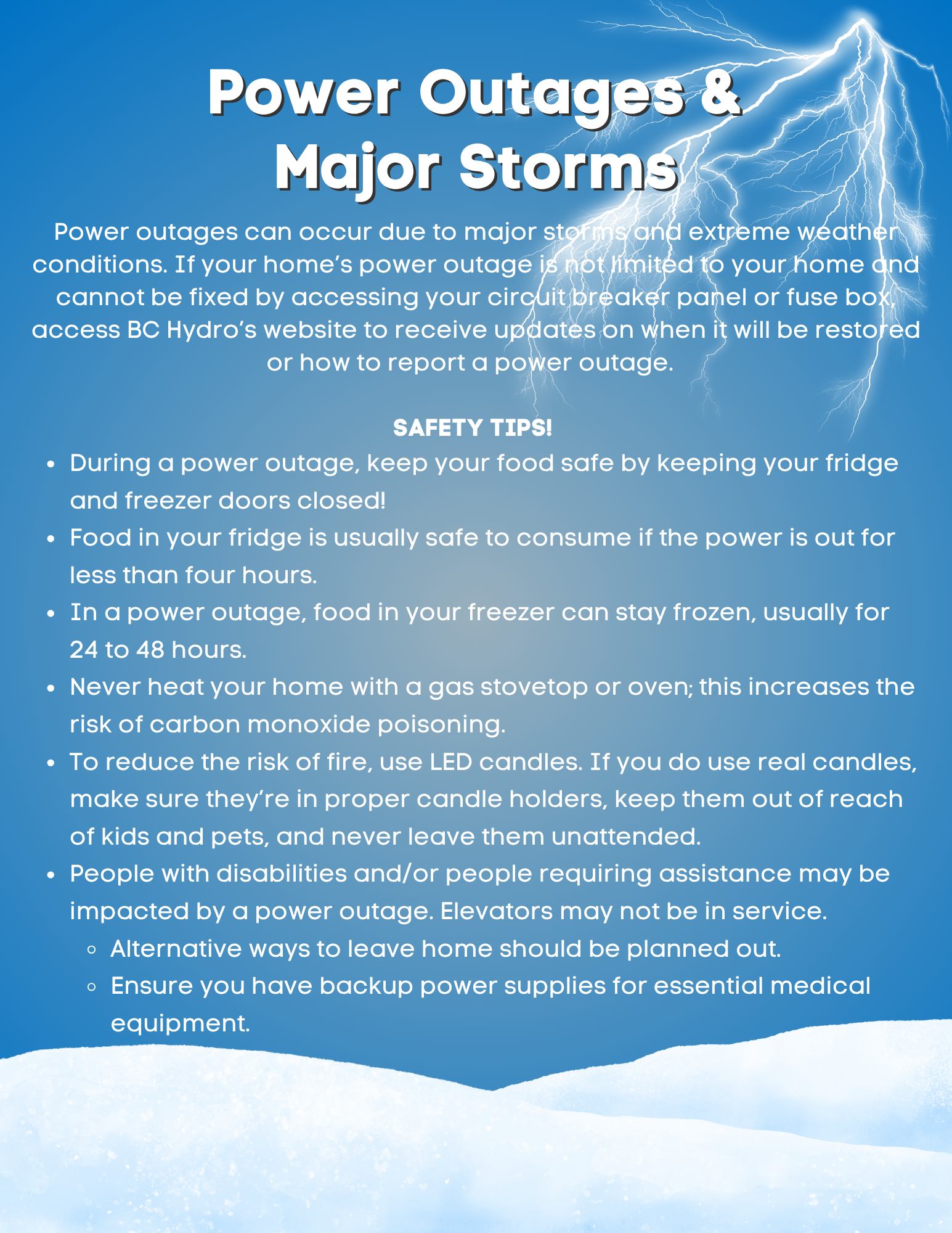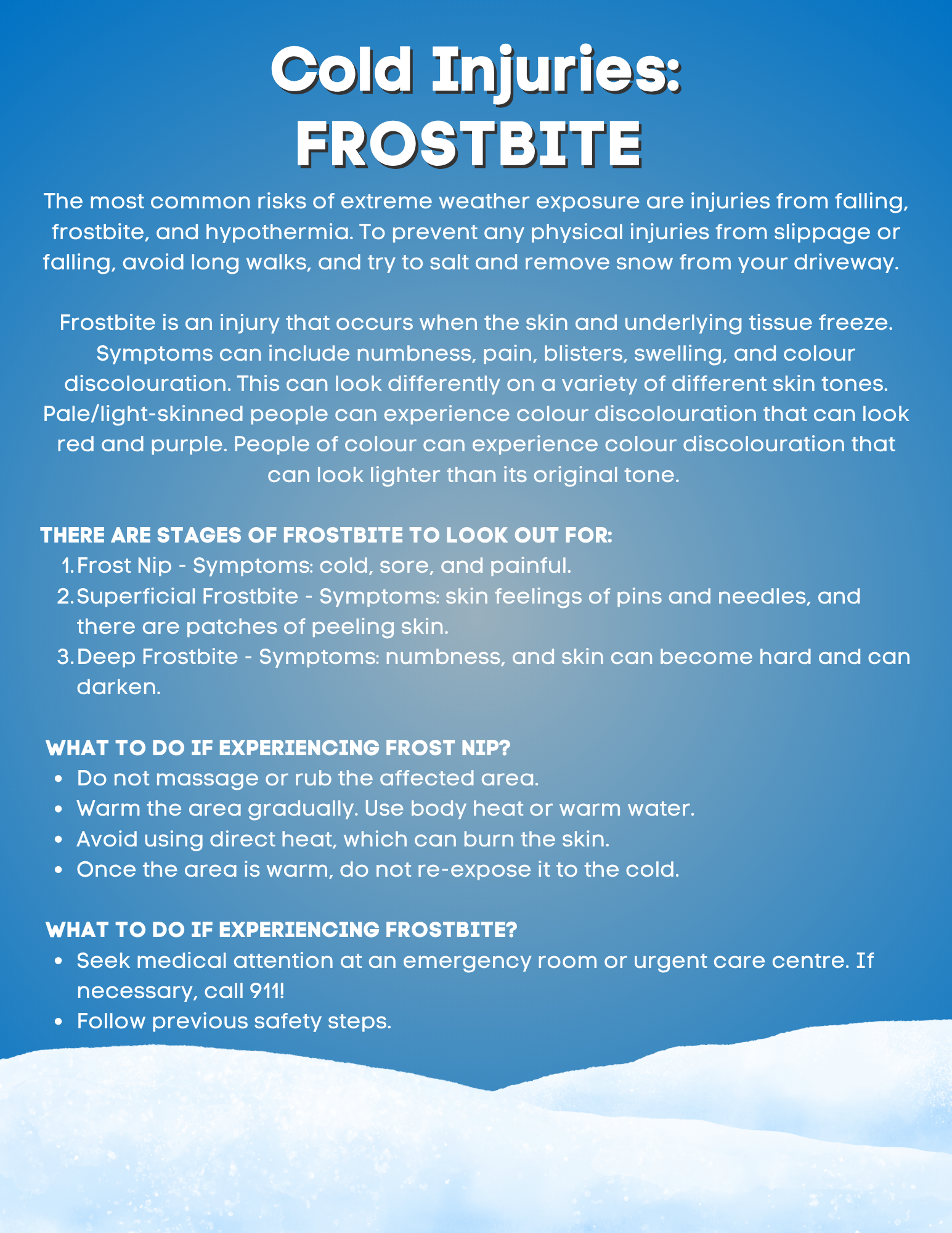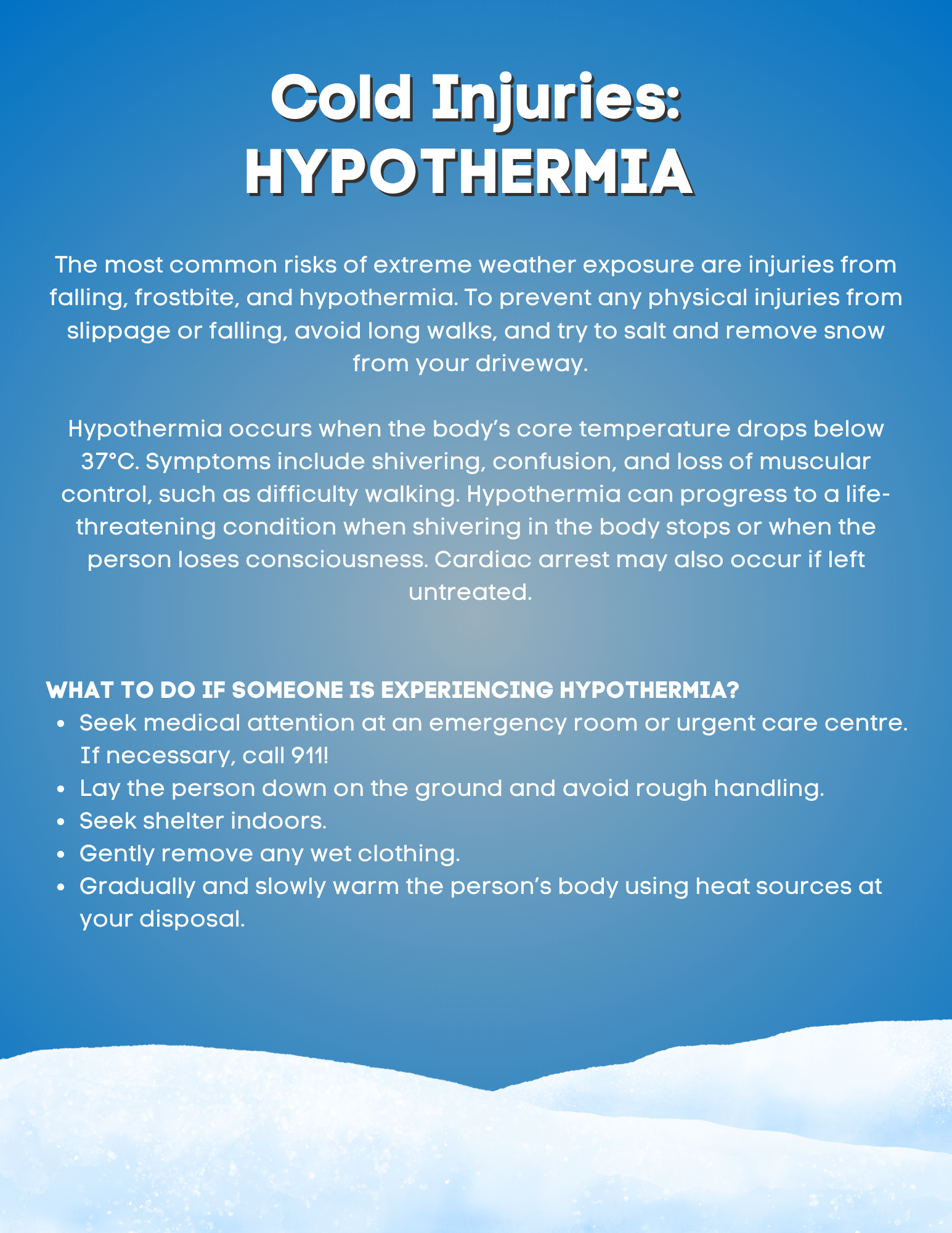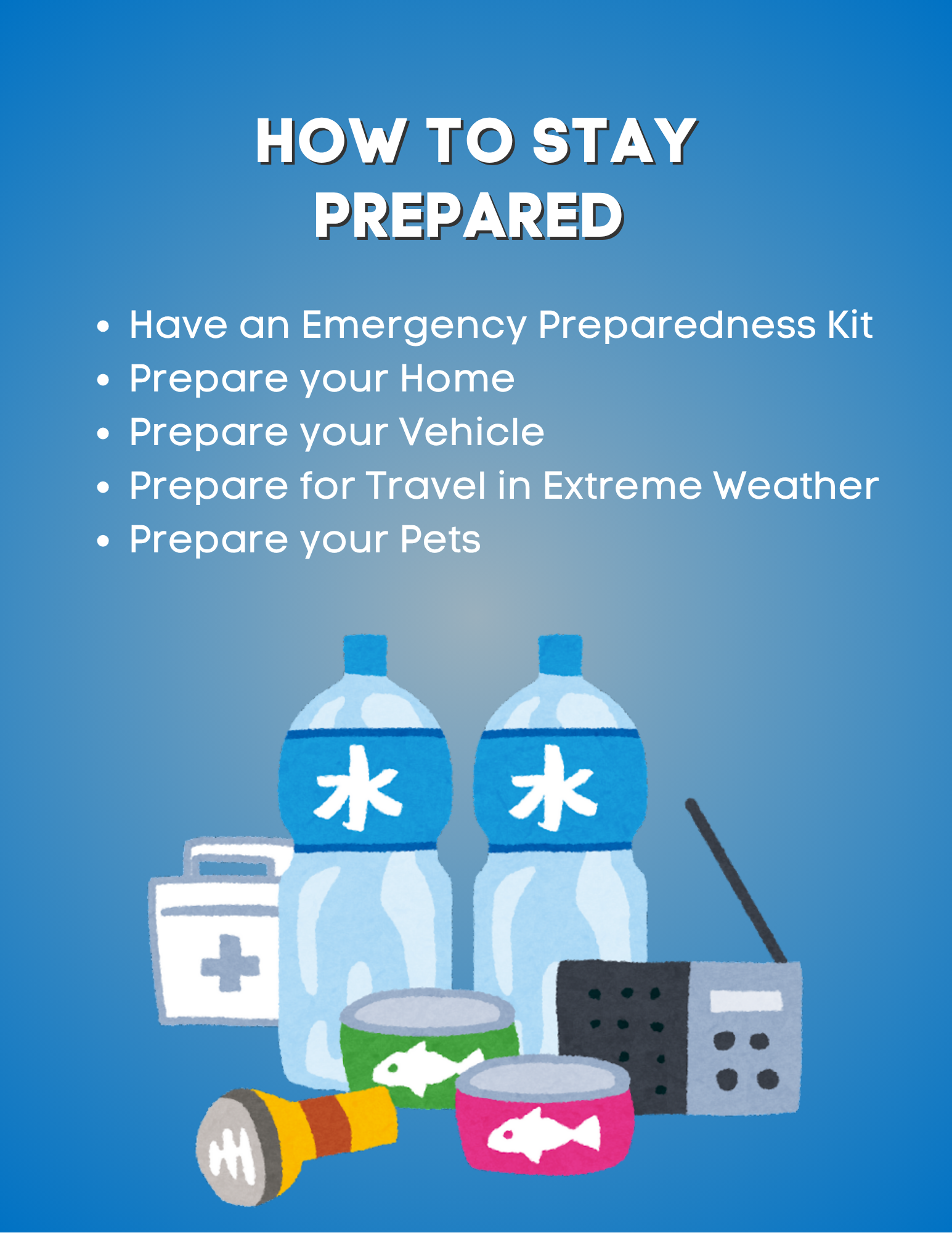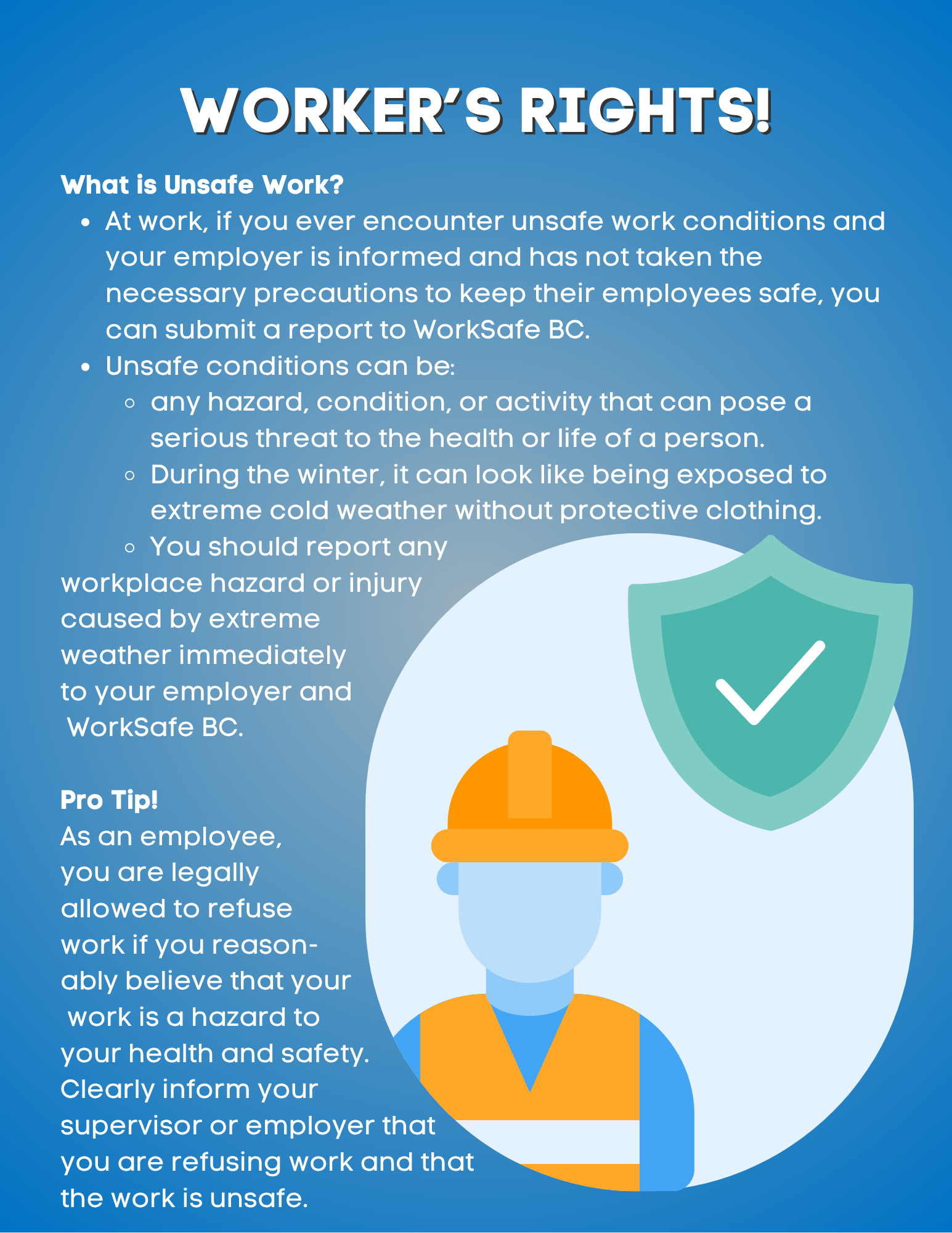Identifying the Risks: Power Outages and Major Storms
Power outages can occur due to major storms and extreme weather conditions. If your home’s power outage is not limited to your home and cannot be fixed by accessing your circuit breaker panel or fuse box, access BC Hydro’s website to receive updates on when it will be restored or how to report a power outage.
Safety Tips!
During a power outage, keep your food safe by keeping your fridge and freezer doors closed!
Food in your fridge is usually safe to consume if the power is out for less than four hours.
In a power outage, food in your freezer can stay frozen, usually for 24 to 48 hours.
Never heat your home with a gas stovetop or oven; this increases the risk of carbon monoxide poisoning.
To reduce the risk of fire, use LED candles. If you do use real candles, make sure they’re in proper candle holders, keep them out of reach of kids and pets, and never leave them unattended.
People with disabilities and/or people requiring assistance may be impacted by a power outage. Elevators may not be in service.
Alternative ways to leave home should be planned out.
Ensure you have backup power supplies for essential medical equipment.
Cold Injuries: Frostbite
-
Frost Nip
– Symptoms: cold, sore, and painful.Superficial Frostbite
– Symptoms: skin feelings of pins and needles, and there are patches of peeling skin.Deep frostbite
– Symptoms: numbness, and skin can become hard and can darken.
-
Do not massage or rub the affected area.
Warm the area gradually. Use body heat or warm water.
Avoid using direct heat, which can burn the skin.
Once the area is warm, do not re-expose it to the cold.
-
Seek medical attention at an emergency room or urgent care centre. If necessary, call 911!
Follow previous safety steps.
The most common risks of extreme weather exposure are injuries from falling, frostbite, and hypothermia. To prevent any physical injuries from slippage or falling, avoid long walks, and try to salt and remove snow from your driveway.
Frostbite is an injury that occurs when the skin and underlying tissue freeze. Symptoms can include numbness, pain, blisters, swelling, and colour discolouration. This can look differently on a variety of different skin tones. Pale/light-skinned people can experience colour discolouration that can look red and purple. People of colour can experience colour discolouration that can look lighter than its original tone.
Cold Injuries: Hypothermia
What to do if someone is experiencing hypothermia?
Seek medical attention at an emergency room or urgent care centre. If necessary, call 911
Lay the person down on the ground and avoid rough handling.
Seek shelter indoors.
Gently remove any wet clothing.
Gradually and slowly warm the person’s body using heat sources at your disposal.
Hypothermia occurs when the body’s core temperature drops below 37°C. Symptoms include shivering, confusion, and loss of muscular control, such as difficulty walking. Hypothermia can progress to a life-threatening condition when shivering in the body stops or when the person loses consciousness. Cardiac arrest may also occur if left untreated.
How to Stay Prepared
-
Non-perishable foods/ready-to-eat food.
Water
Cash
First-aid kit
Portable radio
Seasonable clothing
Personal toiletries
Baby items, pet food, medical prescriptions, etc... as needed
-
Add pets to your emergency plan.
Protect your pet’s paws on walks by putting boots on their paws.
Protect your pet’s paws on walks by messaging their paw pads with petroleum jelly or paw creams to protect from the salt on sidewalks.
If you have a pet, you can use alternatives to salt to de-ice your sidewalk and driveway. Such as sand, kitty litter, vinegar, coffee grinds, and pet-safe ice melt.
Know your pet’s limits being outdoors. If you are feeling cold, your pet is most likely feeling cold as well.
If you think your pet requires additional heating at home, you can provide them with a pet heating pad.
Watch for signs of hypothermia in your pet: whining, shivering, anxious, or moving slower than usual, or seems weak.
If you suspect your pet is experiencing hypothermia, consult an animal hospital immediately.
-
Protect your body’s extremities, such as ears, fingers, toes, and nose, as they are at risk of frostbite. Bundle up with accessories such as hats or earmuffs, gloves, thick socks, and scarves.
Make sure to layer up!
It’s good to start with a base layer of winter clothing to keep yourself dry. It’s recommended to wear thermal clothing or a long-sleeve shirt.
Then wear a middle layer of winter clothing. This can include sweaters, hoodies, flannels, or other similar clothing items.
Lastly, wear an outer layer of rain gear to protect yourself from rain, snow, and wind. A good winter jacket is most common.
To protect your feet from rain and snow, wear waterproof winter boots!
-
Use a shovel and salt to remove snow and ice from your sidewalk and driveway to prevent injury from slips and falls.
Learn how to prevent your pipes from freezing.
Speak to your household members about what you would all do during a winter weather-related emergency.
Create an Emergency Preparedness Kit.
Make sure your furnace is working efficiently.scription
-
Make sure your windows are sealed.
Consider applying silicone caulk that’s labelled as ‘removable’ to spots along the windows where the old caulk has gone. This is a great option for renters because it’s not permanent.
Apply a window insulation kit or weatherstripping, found in most hardware stores.
Apply weatherstripping to your external doors to prevent air leaks.
Install door sweeps to the bottom of exterior doors to block drafts.
-
Heat your rooms strategically to prevent wasting energy by closing all unused rooms and spaces.
Make sure no vents are blocked off by furniture for proper airflow.
Keep yourself warm with layers.
Wear warm socks and slippers, and keep your floors insulated by adding rugs if needed.
Use blankets in common spaces to stay cozy.
Sustain a steady temperature during the day and turn your thermostat down a few degrees while you sleep.
This helps conserve energy at night and prevents your furnace from working overtime.
If it’s sunny in the daytime, open the curtains to your windows where sunlight is coming. Allow the sun to warm up the space and close your curtains when the sun goes down.
-
Carry blankets in your car for warmth.
Carry rock salt in your car to melt ice and improve traction.
Carry an Emergency Preparedness Kit in your car.
Carry brushes and scrapers to remove ice and snow from your car windows and roof for safety.
Carry a small shovel in your car for snow removal.
Equip your car with winter tires to prevent accidents on the road.
Workers’ Rights
-
At work, if you ever encounter unsafe work conditions and your employer is informed and has not taken the necessary precautions to keep their employees safe, you can submit a report to WorkSafe BC. Unsafe conditions can be any hazard, condition, or activity that can pose a serious threat to the health or life of a person. During the winter, it can look like being exposed to extreme cold weather without protective clothing. You should report any workplace hazard or injury caused by extreme weather immediately to your employer and WorkSafe BC.
-
Report unsafe work anonymously by calling WorkSafe BC’s prevention emergency line at 604-276-3301 in the Lower Mainland OR toll-free at 1-888-621-7233.
To report unsafe work online, follow the link to this online form; it is monitored during normal business hours. Click Here
If you have a question about workplace safety, you can contact WorkSafe BC Monday to Friday, from 8:00am to 4:30pm. Call 604-276-3301.
Pro Tip! As an employee, you are legally allowed to refuse work if you reasonably believe that your work is a hazard to your health and safety. Clearly inform your supervisor or employer that you are refusing work and that the work is unsafe.
-
Exposure to natural or artificially cooled environments.
Exposure to wind — pulling heat away from the body.
Using wet clothing from sweat or water for long periods of time.
Cold water immersion cools the body faster than cold air.
Heating centres & Emergency Numbers
Heating centres in the Lower Mainland:
For current information about warming centres and emergency shelters in your area, we encouraged you to visit your local community website, X (formerly Twitter), or Facebook.
Most warming centres open during Extreme Weather Warnings or when the temperature drops to -4°C. During winter weather emergencies, visit www.EmergencyInfoBC.ca. For information about how to stay safe, follow @EmergencyInfoBC on X.
Emergency contact numbers:
Call 9-1-1. For emergencies that require fire hazard attention, medical attention, or police attention.
Call 8-1-1. For deaf or hard-of-hearing call 7-1-1. This phone line is for health-related and non-emergent information and advice. Access this 24-hour phone line operated by HealthLink BC. You will be directly connected with a qualified medical professional, registered nurse, registered dietitian, or pharmacist.
Call 310-6789. For immediate mental health support or referral, you can access this toll-free BC crisis line.
Safety Tips:
-
Check the weather forecast up to a week in advance to prepare for changes in temperature and precipitation. S
tay tuned for extreme cold weather warnings and storm or blizzard alerts.
-
Prepare to leave early to avoid traffic due to extreme weather.
If you take transit, download the TransLink app to be notified of any bus or SkyTrain delays.
For safety, avoid using an umbrella while walking during a storm or a blizzard.
-
Dress warmly and in layers to protect against the cold.
Wear hats, gloves, thick socks, and scarves to protect your extremities.
-
Wear waterproof gear to remain dry because wet clothing makes your body colder more rapidly.
-
When the temperature drops excessively and there are high winds, seek shelter and limit your time outdoors.
-
Watch for signs and symptoms of hypothermia, frostnip, and frostbite.
Some people are at higher risk of cold injuries, such as the elderly, children, and disabled people.

